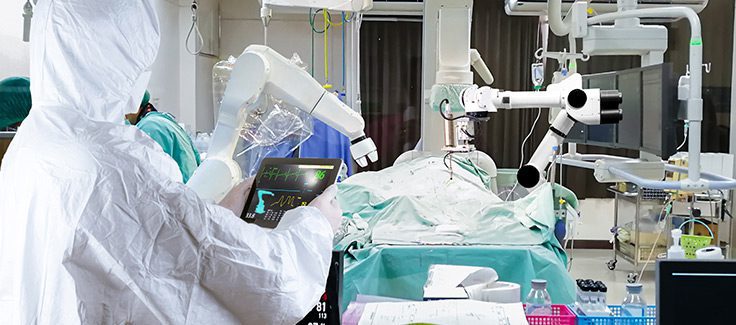The Field of Surgery in Latin America Continues Evolving
The health sector has been undergoing a transformation for a while. It is time to look at medicine from another perspective, with less pain and less stress, as hospitalization offers shorter stays and ever faster recovery. Continuous innovation in the health sector benefits the patient without compromising either their safety or the quality of their care.
One example of this is the Fundación Medellín San Vicente Hospital, which continues to position itself as a touchstone in gastrointestinal surgery thanks to the implementation of a renovated laparoscopy wing able to provide early diagnoses and address highly complex diseases. The hospitals of San Benjamín de Colón, San Antonio de Gualeguay, and Santa Rosa de Villaguay in Argentina are, for their part, also aiming toward less invasive surgery and shorter recovery times by purchasing modern laparoscopic equipment for their operating rooms to complement the existing equipment and perform procedures with enhanced imaging quality.
Minimally invasive surgery (MIS) is gaining importance in Latin American hospital centers. Invented in the early eighties, MIS steadily grew in followers thanks to technological advances. Currently, nearly 80% of elective surgery is done using this method. The technique consists in performing minimal incisions—or even no incision at all by using natural orifices—through which a thin, tube-like device fitted with a video camera and light source, known as an endoscope, is inserted, allowing the surgeon to visually explore cavities inside the body.

Minimally invasive surgery is split into three categories:
- Endoscopy: the surgeon uses an endoscope inserted into the patient’s natural cavities, without making incisions of any kind.
- Laparoscopy: the surgeon inserts the endoscope into the patient through small incisions to perform the surgery.
- Robotic surgery: the surgical instruments are fastened to robotic arms that the surgeon manipulates with millimetric precision by remote control.
According to GHI’s Medical Equipment Market Report: Latin America 2022, the equipment used for this type of surgery has made headway into Latin American markets. For example, in 2021:
- Argentina saw an increase of more than 60% in surgical robotic systems
- The use of laparoscopic surgical equipment grew by more than 7.2% in Mexico
- The use of endoscopies in Colombian hospitals increased by almost 20%
The Medical Equipment Market Report: Latin America 2022 can be obtained directly from GHI. Contact us if you would like to find out more about the variety of data included in the report and how to get it.
“Modern” Surgery Is No Guarantee of Success
Surgical procedures like those mentioned above have multiple advantages over traditional surgery, as they reduce soft-tissue trauma and blood loss, shorten recovery times, and achieve better esthetic results. It should be noted that, although these operations are considered safe, it is possible that, as with other surgical procedures, various complications may occur related to anesthesia, the presence of bleeding, or some kind of infection.
Lastly, a no less important aspect is that unfortunately not all the body’s organs or tissues can be operated on with minimally invasive surgery, and although these kinds of limitations start disappearing as technological advances, it is not yet applicable in all operations.

Robotic Surgery Is Still Making Good Headway
Robotic surgery started more than 30 years ago in the United States thanks to a combination of NASA’s Jet Propulsion Laboratory and private enterprise, which together established RAMS (Robot Assisted Micro Surgery). For the first time ever, a robot took part in a surgical operation when the PUMA 560 was used to insert a needle to do a brain biopsy. This experiment has made it possible to perform operations that used to take months of preparation and recovery before the use of robots, enabling brief, precise procedures with great results.
Although it has taken time to penetrate in Latin America, there has recently been somewhat of a boom in robotic surgery in the region. For example, in Mexico, Hospital Ángeles remains at the leading edge of technology with its Robotic Surgery Center, which has the Da Vinci XiHD Surgical System. The system is capable of performing oncological, gynecological, and pediatric procedures, among others. Similarly, medical centers like the Israelita Albert Einstein Hospital in Brazil have a Center of Excellence in Robotic Surgery to train surgeons in minimally invasive procedures of this kind.
Aside from these specific examples, in July 2022 we published HospiRank 2022, a report on the best equipped hospitals in the region. We included a section on robotic surgery showing there are currently 170 robotic surgical systems throughout the region, distributed as follows:
- Brazil – 50% of the region’s robots
- Mexico – 15% of the region’s robots
- Chile – 11% of the region’s robots
- Other countries – 5% of the region’s robots
Robotic surgery has gained ground in Latin America and other markets because of its considerable advantages: primarily, it enables surgeons to perform highly precise surgical procedures without having to be in the operating room. They can perform the surgery from a workstation by visualizing the inside of the body in a three-dimensional image. Although the operation may take longer than traditional endoscopic surgery, preliminary preparation makes for highly reliable and safe results.

Nanomedicine Is Not Far Behind
We should not talk about robotic surgery and technology without mentioning nanomedicine, which is the application of nanotechnology to biomedicine. The aim of nanomedicine is to construct, repair, control, and protect human biological systems through intervention on a molecular and nanometric scale for healthcare purposes.
Nanomedicine is divided into four steps:
- Nanodiagnostics: detection of the disease at the cellular or molecular level
- Nanotherapy: the use of drugs acting selectively to destroy cell alteration so as not to damage healthy cells
- Regenerative medicine: tissue and organ regeneration through the application of gene or cell therapy, or doses of bioregenerative substances
- Controlled drug release: nanotechnology is used to introduce a drug that is designed to recognize the damaged area and then destroy it without affecting other structures in the body
When it comes to developing and adopting new leading-edge technologies, the region has some considerable challenges facing it, such as poverty, lack of resources, and inequality, which interfere with growth. According to a study by the United Nations Conference on Trade and Development, Brazil is the Latin American economy best prepared to approach this kind of technology.
Robotic surgery, together with artificial intelligence, nanomedicine, and big data, are at the forefront of a technological movement with the potential to transform the health sector and our lives forever.
Technology moves fast, offering infinite possibilities. Good planning is a way to make firm steps toward success. Contact our team of researchers who, through In-Scope, our made-to-measure market research service, will help you source the necessary data to understand the present market and the growth opportunities in the sector.
Next Steps
Contact us to find out how we can help you better understand the impact of these surgical advances in the region. To get started, you can explore a subscription to SurgiScope, the only database available that records the surgical procedures performed in various Latin American countries. The database can give you an understanding of the procedures they most often perform, allowing you to gauge future product demand in terms of surgical equipment, devices, or instruments.
If you need to learn more about the growing market for robotic surgery in Latin America, nanomedicine, or other surgical breakthroughs, we can design and execute a personalized study for your company to bring into focus the opportunities, trends, challenges, and more.





